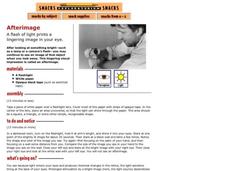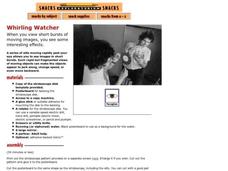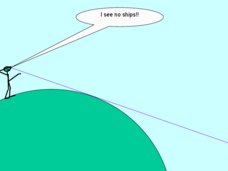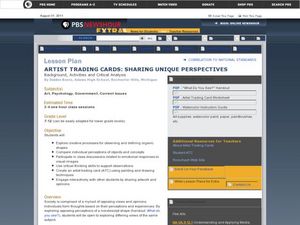Exploratorium
Jacques Cousteau in Seashells
Visionaries create images out of dots to demonstrate the eye-brain connection. Through this activity, they learn that the brain interprets data collected by the eye into recognizable information. Search online for "Jacques Cousteau in...
Exploratorium
Afterimage
To illuminate how afterimage occurs, create a star, square, or other geometric-shaped light for learners to look at for 30 seconds. Then, have them explain what they see as they shift their focus to a blank wall. A full explanation of...
Exploratorium
Cheshire Cat
Divide your field of vision in two and see what happens when your two eyes behold two different scenes! This is a way to demonstrate to body-systems buffs how the two eyes usually blend pictures to create a three-dimensional view. This...
Exploratorium
Bird in the Cage
When your life science class is learning about the eye and how it works, you can add this activity as a demonstration of how the retina holds an afterimage. After staring at a red, green, or blue bird shape, pupils glance at a cage and...
Exploratorium
Whirling Watcher
Pupils put together their own stroboscopes so that they can observe how cyclically moving images appear to merge into a singular object. This, and several other activities published by the same source, illuminate the way the brain...
Exploratorium
Far Out Corners
Construct a three-dimensional optical illusion when your class is exploring vision and how the eye and brain work together. Three concave corners are mounted inside of a black box, but as a light is shined upon them, they appear to be...
Exploratorium
Fading Dot
Fuzzy edges cause an image to fade from view in an activity intended to demonstrate how vision works.
Curated OER
Studying our Senses
Who would not want an opportunity to taste jellybeans in class? During this investigation, life science learners hold their noses as they take a taste test and find that our perception of flavor is connected with our sense of...
Curated OER
The Lines of Perception
Here are four engaging lessons that focus on visual art, but also bring in elements of science and social studies. Learners view artwork, locate focal points, and visit and research community sites. They conduct internet research, and...
Media Smarts
Cinema Cops
A study of how public perception is both reflected and influenced by film and television, this instructional activity helps young scholars develop an awareness of audience as well as a critical view of media. Depictions of police in...
Curated OER
Faulkner's The Sound and the Fury: Benjy's Sense of Time
Students explore iam Faulkner's novel, "The Sound and the Fury" to investigate his use of time and how this quality relates to the novel's form and content. They grapple with questions of perception, history, and chronology through this...
Exploratorium
Antigravity Mirror
Is it a bird? Is it a plane? It's super student! Physical science stars can fly during a unit on light as they see the reflection of one leg in a mirror, behind which the other holds them up.
Curated OER
Earth is Round
This series of images shows how ancient people figured out that the world was round. Each slide shows a ship moving around the globe and coming closer to the line of the observer's sight. This is a very simple resource that you could use...
Curated OER
Outgroup Experiment Reveals Bias, Stereotyping
Exploring bias and stereotypes, students dress up as members of "outgroups" (groups of people who are often judged). Though the lesson specifies that it should be "respectful and not mock the outgroup in any way," this activity would be...
Curated OER
Is Your Blue Really Blue? [Metamerism]
Students examine color perception and how it relates to metamerism. In this color lesson students complete a lab activity that shows them the three basic components of color perception.
Curated OER
Women and Sports
Students examine how women in sports has changed over the years. For this women in sports lesson students research the benefits of being active.
Curated OER
Applied Science - Science and Math Post-Lab
Students explore optical illusions. In this Applied Science lesson, students view optical illusions and record the data of what they see. Students graph the data that they collect.
Curated OER
Artist Trading Cards: Sharing Unique Perspectives
Students examine inkblot images. In this visual arts lesson, students consider perception as an element of art as they partipate in activity that requires them create and analyze inkblot art. Students analyze several pieces of art...
Curated OER
Perception and the Brain
Students experience how the brain adapts over time to changes in what they perceive. In this human perception instructional activity, students wear special prism goggles that initially disorient the user. Over time, the student is able...
Curated OER
Breezy, Chilly, or Freezing?
Students assess the factors which influence the sensation of being "cold" in a particular situation. They study the complexities in measuring temperature by reading and discussing the article "Beyond Brrr: The Elusive Science of...
Curated OER
Hand Sensitivity
Students experiment with the sense of touch. In this tactile instructional activity, students determine the most sensitive area of the hand. Students experiment by describing objects through touch only. Students compare the amount of...
Curated OER
Optical Illusions
Students investigate optical illusions. In this optical illusions lesson plan, students explore perception. Students analyze optical illusions and determine common misconceptions.
Curated OER
Measuring Visual Acuity
Students examine the principles of visual acuity and how it pertains to sight. In this measuring lesson students complete several activities on vision.
Curated OER
Using Historical Photographs to Help Students "Live History"
Third graders grasp a deeper understanding of historical time periods when vicariously experienceing the situations and circumstances of real-life individuals and responding to them.
















![Is Your Blue Really Blue? [Metamerism] Lesson Plan Is Your Blue Really Blue? [Metamerism] Lesson Plan](http://content.lessonplanet.com/resources/thumbnails/299613/large/otq2otizlmpwzw.jpg?1315624134)








